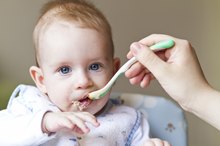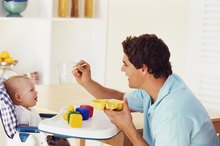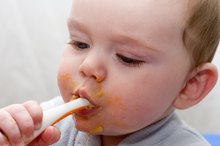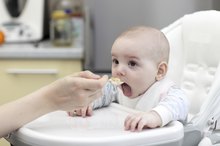When Do Babies Stop Jar Food?
Babies' first solid foods often come from a jar, and they may continue to eat jarred food for several months or longer. A variety of food is available in jars for babies, from finely pureed fruits and vegetables for babies just starting solids to chunky stews and finger foods for toddlers. When you stop buying food in a jar is really up to you, but some guidelines can help you decide.
Benefits of Jarred Food
Baby food in a jar is convenient; you can keep a few jars in your diaper bag so your baby always has a meal ready. When babies are young they need to eat frequently, so it's nice to have a small stock of healthful foods on hand wherever you go. Baby food in a jar comes in small portions, just right for a baby. You don't have to worry about making too much of something and having it go bad. Because it's in sealed jars, baby food doesn't have to be refrigerated before it's open, so you can store it in a cabinet.
- Baby food in a jar is convenient; you can keep a few jars in your diaper bag so your baby always has a meal ready.
- When babies are young they need to eat frequently, so it's nice to have a small stock of healthful foods on hand wherever you go.
Learning to Eat
4-Month-Baby Diet
Learn More
When babies are first starting solids, they have to learn how to eat from a spoon. For the first 4 to 6 months, baby has only had to suck to receive her food. Now she has to move her mouth in a whole new way. Babies can't chew food when they're first starting solids, either, so they need food that's very soft, nearly liquid. As your baby gets older, more teeth come in, and she perfects the art of swallowing from a spoon. Then you can start giving her food with a little more texture and start incorporating soft finger foods. You can buy food in jars for older babies and toddlers, or you can start giving her portions of what you're eating.
- When babies are first starting solids, they have to learn how to eat from a spoon.
- Babies can't chew food when they're first starting solids, either, so they need food that's very soft, nearly liquid.
Feeding Safety
Even though your baby at 1 year old can eat most of what you can eat, he can still choke if his food is too hard or the pieces are too large. Jarred baby food is soft and easy to chew, and the pieces are very small. If you want to get away from the jar food, make sure you cook all your baby's food until it's soft or give him things that are naturally soft, like bananas. Cut his food into very small chunks to reduce the risk of choking.
- Even though your baby at 1 year old can eat most of what you can eat, he can still choke if his food is too hard or the pieces are too large.
- If you want to get away from the jar food, make sure you cook all your baby's food until it's soft or give him things that are naturally soft, like bananas.
Transitioning from Jar to Table
List of Vitamin C Rich Foods for Babies
Learn More
Around 8 months, your baby is probably ready to start eating food with more texture. She no longer needs all her food to be pureed, so you can start feeding her from the table. Offer soft foods such as soft cheeses, cooked chunks of apple and carrot, and O-shaped cereal to help her develop her self-feeding skills. Any food you give your baby should be smaller than the tip of your finger and be able to be crushed between your thumb and forefinger. If it's too hard, such as raw carrots, save it for when she's older. Baby can now eat pasta, small pieces of meat, soups and just about anything else you cook that's soft and easy to chew. Make sure her food isn't too hot, and stay away from food that's very spicy or greasy. Stick to healthful choices, and avoid things like fast food and sugary snacks. Avoid honey in the first year; it can lead to botulism in infants. By the time your baby is a year old, she can probably eat the same things the rest of the family is eating, but you may want to keep a few jars of baby food on hand for when you serve a spicy meal or need something for baby on the go 1.
- Around 8 months, your baby is probably ready to start eating food with more texture.
- Offer soft foods such as soft cheeses, cooked chunks of apple and carrot, and O-shaped cereal to help her develop her self-feeding skills.
Related Articles
References
- Baby Center: Age-By-Age Guide to Feeding Your Baby
- Family Education: Infant Feeding Guide
- Pendick D. Harvard Health Publishing. How much protein do you need everyday? Updated June 25, 2019.
- MedlinePlus. Human insulin injection. Updated October 15, 2019.
- Njike VY, Smith TM, Shuval O, et al. Snack food, satiety, and weight. Adv Nutr. 2016;7(5):866-78. doi:10.3945/an.115.009340
- U.S. Department of Agriculture. ChooseMyPlate.
- Office of Disease Prevention and Health Promotion. USDA food patterns: healthy U.S.-style eating pattern 2015-2020.
- National Center for Health Promotion and Disease Prevention. Eat wisely. Updated February 10, 2020.
- Shaw P, Walton J, Jakeman P. The effects of the Special K Challenge on body composition and biomarkers of metabolic health in healthy adults. Journal of Nutrition and Health Sciences. 2015;2(4). doi:10.15744/2393- 9060.2.403
Writer Bio
April Fox has published articles about homeschooling, children with special needs, music, parenting, mental health and education. She has been a guest on Irish radio, discussing the benefits of punk rock on child development, and currently writes for several websites including Carolina Pediatric Therapy.









